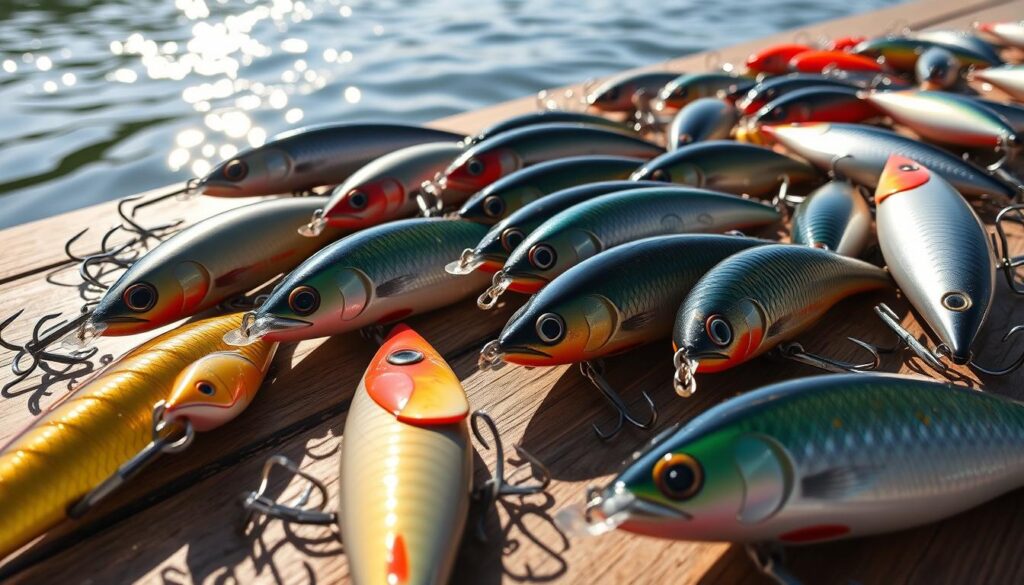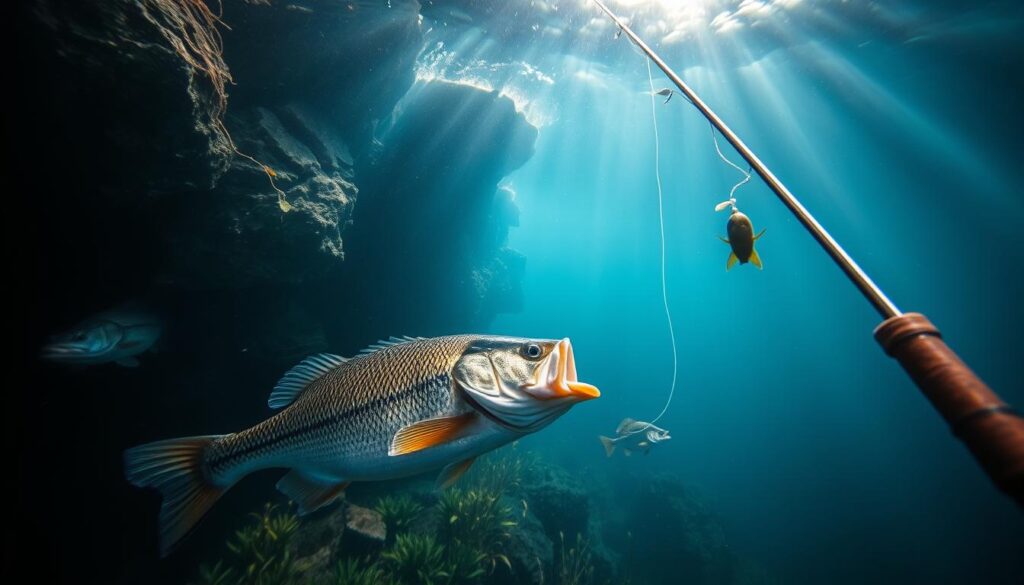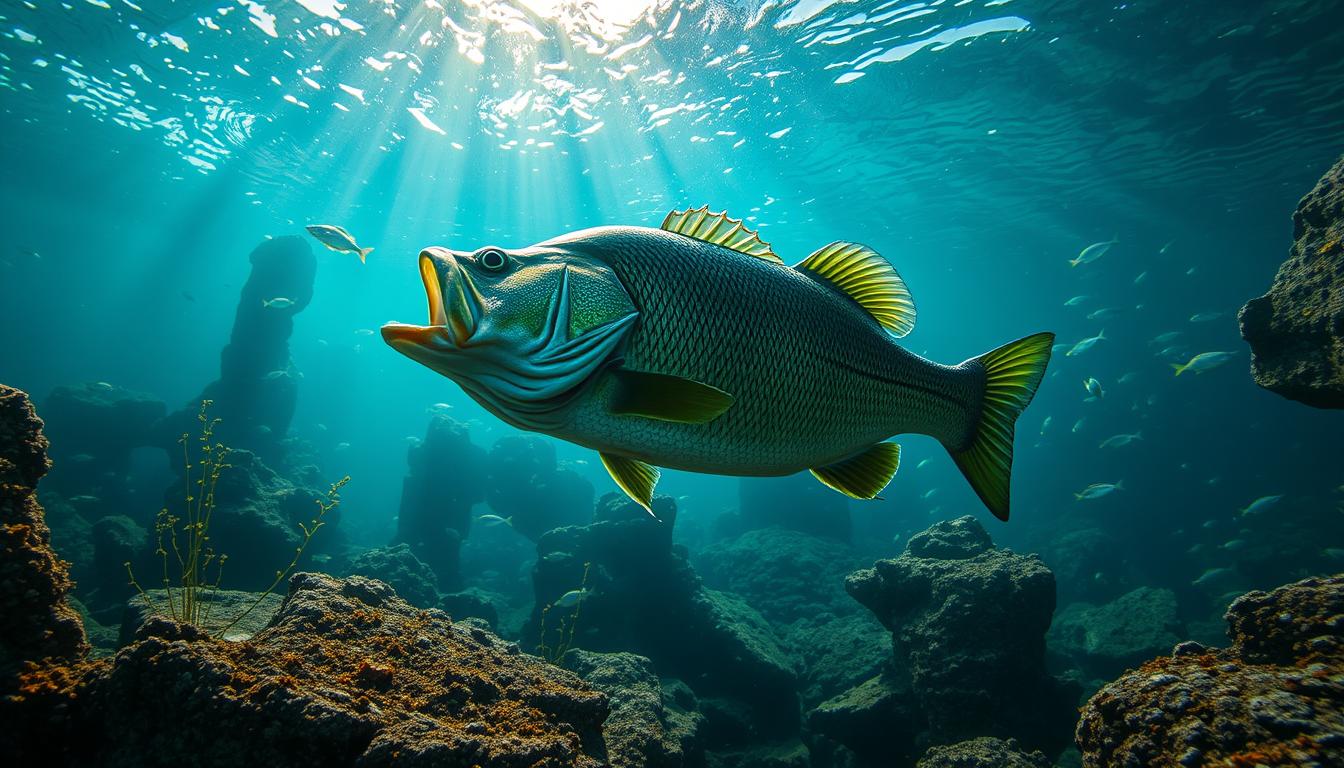Deepwater bass fishing is a thrilling challenge for anglers. It offers the chance to catch bigger, trophy bass. Most anglers fish in shallow waters, but deep areas have fewer fish. This means bass can grow bigger without as much pressure.
To catch bass in deep water, knowing their seasonal habits is key. In spring, bass move from deep to shallow waters to spawn. They might even spawn as deep as 30 feet in clear water. But, late summer and fall are best for finding bass in their deep, cool homes.
For deep-water bass fishing, you need the right gear and to understand fish behavior. Using the latest electronic tools helps find these big fish. With these skills, you can catch bigger bass and have a rewarding fishing experience.
Table of Contents
Understanding Bass Behavior in Deep Waters
To catch bass in deep water, you need to know their habits. Bass changes their behavior with the seasons and water temperature. They adapt to their surroundings in different ways.
Seasonal Deep Water Patterns
In winter, water is between 55 to 60 degrees, and bass fishing is okay. As winter ends, bass go to mid-depths, 15 to 20 feet. Then, they move deeper as the temperature falls below 48 degrees.
In spring, when the water warms up to 60-65 degrees, bass go shallower to spawn. Anglers need to switch to lures like crawfish-colored crankbaits or green pumpkins.
Temperature Impact on Bass Location
Water temperature greatly affects bass behavior and where they are. Bass like depths of 40 to 50 feet with clear water, especially when it’s below 48 degrees. Anglers use special techniques like jigging spoons or tail spinners to catch them.
When summer comes, with temperatures over 75 degrees, bass change their habits. They are most active in early mornings, sunsets, and nights. Large worms, jigs, and Hawg Craw baits work well during these times.
Deep Structure Bass Habits
Bass gather around certain deep structures like sand-to-mud or sand-to-gravel areas. They ambush prey there. Single boulders or small gravel veins on sand flats are also good spots for finding bass.
Knowing these patterns is key for catching big bass in deep water. It helps anglers find and catch trophy bass consistently.
| Season | Water Temperature | Bass Behavior | Recommended Techniques |
|---|---|---|---|
| Winter | 55-60°F | Moderate activity, moving to mid-depth waters (15-20 feet) | Jigging spoons, tail spinners, football jigs |
| Spring | 60-65°F | Moving to shallow waters for spawning | Crawfish-colored crankbaits, green pumpkin lures |
| Summer | 75-90°F+ | Active during early morning, sunset, and night | Large worms, jigs, Hawg Craw baits |
| Fall | Cooling temperatures | Increased activity, targeting baitfish | Spinnerbaits, crankbaits |
Essential Gear for Deep Water Success
Mastering deep-water bass fishing tactics needs the right gear. Choose baits like tube baits, Ned Rigs, and blade baits. These sink fast and stay in the strike zone longer.
For your line, use Seaguar Tatsu fluorocarbon in an 8-15 lb test. Or mix a 10 lb Seaguar Smackdown Flash Green braid with a 10 lb Seaguar Gold Label fluorocarbon leader. The fluorocarbon is stealthy and tough, while the braid adds distance and feel. You might need stronger rods for the stiffer line.
It’s all about the gear that lets you fish deepwater bass effectively. With the right setup, you’ll catch more fish in the deep.
“The right gear makes all the difference when it comes to deep water bass fishing. Invest in quality, purpose-built equipment and you’ll be rewarded with more bites and bigger fish.”
Deep Water Bass Fishing: Choosing the Right Location
Finding the right spots is crucial for deepwater bass fishing. Whether you’re fishing for structure bass or offshore bass, knowing the best places is key. By knowing where bass like to be, you can catch bigger fish.
Finding Offshore Structure
Offshore structures like ledges, humps, and points are great for deepwater bass fishing. These areas attract bass because they have baitfish. Also, spots where different bottoms meet, like gravel to rock, are good places to fish.
Using Electronics Effectively
Modern fishing electronics are very helpful. They help you see the bottom, find fish, and know the best depths. Get to know your electronics well to fish better.
Key Depth Zones to Target
The best depth for bass fishing changes with the season. But usually, aim for 20 to 65 feet. In early spring, bass are often with perch at 55 feet. During the spawn, they might be as deep as 30 feet in clear water.
| Season | Ideal Depth Range | Key Factors |
|---|---|---|
| Early Spring | 55 feet | Bass mixing with perch |
| Spawning | 30 feet (in clear water) | Deeper bass locations |
| Summer | 20-65 feet | Varied depth preferences |
By knowing about offshore structure, using electronics well, and understanding depth zones, you’ll catch more bass. This will help you master structure bass fishing and offshore bass angling.
Advanced Deep Diving Crankbait Techniques
Mastering deep-diving crankbaits can change the game for bass fishing in deep waters. These lures dive deep, reaching the bass’s favorite feeding zones. Learning the tricks of deep-diving crankbaits can lead to great success in bass fishing.
Choosing the right bait is crucial. Go for lures like the Rapala DT 10 and DT 16, or the Megabass Deep-X 300, Deep Six, and River2Sea Tactical DD 75. These can dive as deep as 10 to 16 feet, covering the water column effectively.
When fishing deep, use your rod tip to guide the crankbait along the bottom. This keeps the lure in the strike zone, increasing your chances of a bass strike. Use high-quality terminal tackle like Owner Hyperwire Split Rings and Owner ST-56 Treble hooks for better hookups.
Line selection is also key. The Fluorocarbon line is great for deep-diving crankbaits, offering better sensitivity and deeper dives. Pair it with a G. Loomis IMX PRO 906 CBR rod and a Shimano Metanium MGL (XG) reel for top performance.
Don’t be shy to try different retrieves. Vary the speed and add pauses to get the bass to strike. In cold water, slow down your retrieve to match the fish’s slower behavior.

By adding these advanced techniques to your bass fishing, you’ll conquer the depths. You’ll unlock the full potential of your deep-water bass fishing tactics.
Mastering Vertical Jigging for Bass
Vertical jigging is a top technique for catching trophy bass in deep water. It lets anglers hit bass in deep spots with great accuracy. Learning vertical jigging can help you catch big bass consistently.
Proper Jigging Cadence
Finding the right jigging rhythm is key. Try different speeds, from quick snaps to slow hops, to see what works best. In cold water, slow movements are often better because bass are less active.
For bass that are suspended, use a “yo-yoing” motion. This means pausing your jig at different depths to attract bites.
Reading Your Line for Strikes
While jigging, watch your line closely for any signs of a bite. Keep your line tight and be ready to hook a fish as soon as you feel a tug. In clear water, even a tiny pause can mean a bass has bitten.
In murky water, you might need to look for bigger signs of a bite. This is because the water makes it harder to see what’s happening.
Optimal Jig Weights by Depth
The weight of your jig depends on the water depth. Use heavy jigs (3/4 oz or more) in deep, fast water to get your bait down fast. In shallower, calmer spots, lighter jigs (3/8 oz) work better for a more subtle approach.
Try different jig weights to find the perfect balance for your fishing conditions.
“Vertical jigging is a game-changer for deep water bass fishing. By mastering the nuances of this technique, you’ll be able to target and consistently catch trophy-sized bass that lurk in the depths.”
Live Bait Strategies for Deep Bass
Live bait is very effective for catching deep-water bass, especially in spring. Bass are hungry then, and live bait like bluegill, shad, or minnows looks and smells good to them. This can make them strike hard.
To use live bait, try a drop shot or Carolina rig. These setups let you place the bait at the right depth. This keeps it where bass are most likely to find it. Always check local rules on using live bait first.
For deep water, use heavy weights to keep the bait right. This keeps the bait moving naturally. Live bait is great when bass are shy or when there’s a lot of fishing pressure. It’s a natural choice that can attract even the most cautious bass.
| Live Bait Options | Advantages | Considerations |
|---|---|---|
| Bluegill | Provides a natural and familiar forage for bass | Requires extra care to keep alive during the fishing trip |
| Shad | Mimics a common food source for bass in deep water | May be more challenging to obtain in some areas |
| Minnows | Versatile and widely available live bait option | Smaller size may be less appealing to larger bass |
The secret to catching deep water bass with live bait is to present it naturally. Pay attention to local rules and how the environment affects bass. With these techniques, you’ll catch deep water bass more often.

Understanding Deep Water Structure
Deepwater bass fishing is all about knowing what’s under the water. Use your electronics to map the bottom. This helps you find places like ledges, humps, and creek channels where bass like to hide.
Look closely at where different bottoms meet, like sand and gravel or rock and mud. These spots are perfect for bass to hang out.
Bass behavior changes with the seasons. In summer and fall, they like main lake points and offshore humps. But in winter, they seek out the deepest spots to escape cold water.
Knowing how bass move between shallow and deep water can help you catch them. By understanding their seasonal patterns, you can set up to catch them as they move.
Mapping Bottom Contours
Take your time to map the bottom of your fishing spot with your electronics. Look for small changes in depth and structure. These can be where bass hide.
Pay special attention to where different bottoms meet. These transition zones are often where bass like to be.
Identifying Fish-Holding Areas
After mapping, find the best spots for bass. Look for ledges, humps, and creek channels. These features attract bass.
Also, search for downed timber, brush piles, or other cover. These provide shelter and ambush points for bass.
Seasonal Structure Patterns
Bass behavior changes with the seasons. In summer and fall, they prefer main lake points and offshore humps. But in winter, they seek the deepest spots to avoid cold water.
“Understanding the seasonal patterns and how bass relate to deep water structure is the key to unlocking the secrets of deep water bass fishing.”
Advanced Electronics and Sonar Techniques
In deep-water bass fishing, modern tech has changed the game. Learning to use side-imaging and down-imaging sonar helps find bass. With GPS, you can mark good spots and map your fishing areas.
Joe Fonzi, a pro angler, has thousands of waypoints. Each one is a boulder, ledge, or key spot. Get to know your electronics well, including how to adjust settings and read fish arches. Some units show real-time fish images, helping you place your bait perfectly.
But, forward-facing sonar has sparked debate in bass fishing. It’s very effective, but some tournaments limit its use. This keeps the game fair. Stay updated on these rules and adjust your bass fishing tactics as needed.
“Forward-facing sonar has become an invaluable tool for locating and targeting deep water bass, but we must also respect the traditions and fairness of the sport. As anglers, we need to find the right balance between technology and skill.”
While tech helps, experience is key. Use your gadgets wisely and know bass behavior and where they live. This combo will help you tackle deepwater bass fishing challenges.
Conclusion
Mastering deep-water bass fishing needs a deep understanding of bass behavior and seasonal patterns. It also requires using modern electronics and fishing tactics. Techniques like deep diving crankbaits and vertical jigging can help catch big bass in deep water.
It’s important to watch water temperature and how it affects bass. Try different lures and lines to find what works best for you. Use advanced electronics to find fish and track their movements.
With dedication and a flexible approach, you can become great at bass fishing tactics in deep water. Always check local fishing rules and handle fish carefully. This way, you’ll have a safe and successful fishing trip.
FAQ
What are the key seasonal patterns for bass in deep waters?
In spring, bass move from 20-50 feet deep to shallower areas for spawning. Some bass in clear waters spawn as deep as 30 feet. Late summer and late fall are the best times to catch bass in deep, clear water.
How does water temperature affect bass behavior in deep water?
Water temperature greatly impacts bass metabolism and feeding. Early spring, bass stay on the bottom from 20-50 feet until the water hits 50°F. In summer and fall, they often suspend in deep water.
What type of gear is best for deep water bass fishing?
Use “power finesse” baits like tube baits with heavy heads (3/8 to 3/4 oz). Also, Ned Rigs with 3/8 oz heads and blade baits are good. For line, try Seaguar Tatsu fluorocarbon (8-15 lb test) or a mix of 10 lb Seaguar Smackdown Flash Green braid with a 10 lb Seaguar Gold Label fluorocarbon leader.
Where should anglers look for deep water bass?
Look for offshore structures like ledges, humps, and points. Also, transition areas where different bottoms meet are great spots. Depths usually range from 20-65 feet, with early spring focusing on 55 feet and spawning bass as deep as 30 feet in clear waters.
What deep water bass fishing techniques are most effective?
Deep diving crankbaits, vertical jigging with various jig weights, and live bait (like bluegill, shad, or minnows) on a drop shot or Carolina rig are very effective.
How can anglers use electronics to improve their deep water bass fishing success?
Modern electronics and sonar, like side-imaging and down-imaging, help map bottom contours and find key structure. They also locate bass in real-time, making bait placement more precise.

